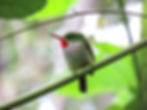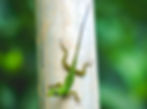Snapshots of El Yunque Fauna
- TRACE
- Apr 12, 2019
- 3 min read
Updated: Aug 5, 2020
By Carolina May, Virginia-Rose Seagal, and Rosanise Odell
While sampling in the field and monitoring the plots, there are plenty of chances to become familiar with creatures of the forest. In El Yunque, we’re lucky; most of our fauna are friendly. Meet some of our favorite inhabitants of the TRACE plots below:

Walking Stick (Order: Phasmatodea)
Walking sticks are nocturnal insects that can be found all around the rainforest if you look closely. They are herbivores and are able to blend in well with their surroundings. Varying species have different patterns of camouflage, from light green (like the individual in the photo) to lichen-imitating patterns. As a method of defense they will loosen their limbs and draw them together against their body so that they are indistinguishable from a stick. You may also see them swaying back and forth to imitate branches blowing in the wind.

Puerto Rican Tody (Todus mexicanus)
A “relict species”, the Tody used to inhabitat lands as far north as Wyoming! Today it remains only in the Caribbean. A pair frequents the trail between Plot 3 and Plot 5, perching on Cecropia branches and showing off their dazzling red throats. Todys are insectivores that catch their prey mid-air. They tend to perch where there are few leaves above or below them so they can get a good view of nearby prey, and it makes them very easy to see. Todys are monogamous and each pair defends their small territory for life.

Tree Snail (Class: Gastropoda, Genus: Caracolus)
Snails of all sizes are abundant in the plots and all throughout El Yunque National Forest, so much so that you must be careful not to step on one! Tree snails can live up to 10-15 years and their shells can reach up to 65mm. They use their tongue, called a “radula” to eat dead and live leaves, fungi, algae, and flowers. You can find tree snails mostly among the vegetation, but be careful touching them because they may carry parasites!

Green Anole (Genus: Anolis)
Anoles of all colors can be found jumping among the vegetation throughout El Yunque. Males have a dulap, or flexible skin around their throat, which they extend when defending their territory or when courting females. They also will do push ups along with dulap extension when they are competing with other males. There are 11 species of Anolis lizards in Puerto Rico and they are able to change their color when they are excited. They are insectivores and perch mostly on tree trunks.

Little Fire Ants (Wasmannia auropuntata)
Little fire ants are an invasive and unfortunately very common stinging pest found in the plots. Like all species of ants, the little fire ant workers are all female. They produce a painful sting disproportionate to their small size and the poison sac in their abdomens contains piperidine alkaloids. They are omnivores who consume other invertebrates as well as plant matter. The little fire ant originated in Brazil although now is an invasive species found all over the globe.

Common Coqui (Eleutherodactylus coqui)
This tiny tree frog is a symbol of Puerto Rico and native to the island. These nocturnal amphibians can be heard as soon as the sun sets with males calling a distinctive “kho kee” to attract females. Coquis eat primarily invertebrates, but have been observed consuming spiders, moths, snails, and occasionally even small frogs. Predators of coquis include the Puerto Rican racer snake, birds and spiders.
Sources:

